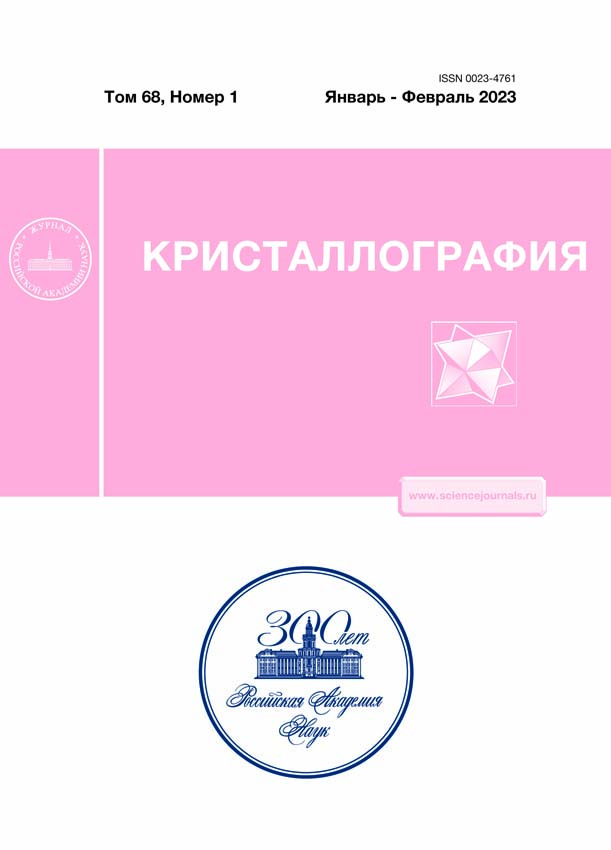STUDY OF THE FORMATION OF RADIATION-STIMULATED IMPURITY DEFECTS IN CaF2CRYSTALS ACTIVATED BY TRIVALENT RARE-EARTH IONS
- Autores: Sarkisov S.E.1, Yusim V.A.1,2, Pisarevsky Y.V.1,3
-
Afiliações:
- National Research Centre “Kurchatov Institute”, Moscow, 123182 Russia
- Moscow Institute of Physics and Technology (State University), Dolgoprudnyi, Moscow oblast, 141700 Russia
- Shubnikov Institute of Crystallography, Federal Scientific Research Centre “Crystallography and Photonics,” Russian Academy of Sciences, Moscow, 119333 Russia
- Edição: Volume 68, Nº 1 (2023)
- Páginas: 68-76
- Seção: МЕТАМАТЕРИАЛЫ И ФОТОННЫЕ КРИСТАЛЛЫ
- URL: https://ter-arkhiv.ru/0023-4761/article/view/673547
- DOI: https://doi.org/10.31857/S0023476123010241
- EDN: https://elibrary.ru/DQXMLN
- ID: 673547
Citar
Texto integral
Resumo
Ionizing radiation gives rise to impurity defects in activated crystals due to the transition of impurity ions from the trivalent to divalent state. An approach is proposed for studying the influence of the energy position of R3+ ions in the energy-band structure of СaF2 crystals on the degree of stability of rare-earth ions in the divalent state as a result of the transition of 4fn electronic states of R3+ → R2+ ions under ionizing irradiation. The processes of direct and reverse photochromism occurring on impurity defects, which are related, respectively, to the coloring of activated crystals under γ irradiation and their bleaching under UV irradiation, have been studied. A mechanism of photochromic transformation taking into account the participation of radiation-induced color centers (CCs) in this process is proposed. The valence transition R3+ → R2+ is considered in terms of photooxidation reaction. The possibilities and conditions of the ion transformation reaction in dependence of the type of ionizing radiation acting on R3+-containing crystals are analyzed based on calculations of the change in the Gibbs energy.
Palavras-chave
Sobre autores
S. Sarkisov
National Research Centre “Kurchatov Institute”, Moscow, 123182 Russia
Email: Yusim_VA@nrcki.ru
Россия, Москва
V. Yusim
National Research Centre “Kurchatov Institute”, Moscow, 123182 Russia; Moscow Institute of Physics and Technology (State University), Dolgoprudnyi, Moscow oblast, 141700 Russia
Email: Yusim_VA@nrcki.ru
Россия, Москва; Россия, Долгопрудный
Yu. Pisarevsky
National Research Centre “Kurchatov Institute”, Moscow, 123182 Russia; Shubnikov Institute of Crystallography, Federal Scientific Research Centre “Crystallography and Photonics,” Russian Academy of Sciences, Moscow, 119333 Russia
Autor responsável pela correspondência
Email: Yusim_VA@nrcki.ru
Россия, Москва; Россия, Москва
Bibliografia
- Brandon S., Derby J.J. // J. Cryst. Growth. 1991. V. 110. P. 481.
- Siegel R., Howell J.R. // Thermal Radiation Heat Transfer. 2-nd Edition. Washington: Hemispher Publishing Corp., 1981. P. 24.
- Сивухин Д.В. Общий курс физики. Оптика. М.: Физматлит. МФТИ, 2002. Т. 4. 792 с.
- Юсим В.А. Дис. “Разработка новых принципов выращивания и управления радиационным дефектообразованием в структурах кристаллов фторидов”… канд. техн. наук. Долгопрудный: Переплетофф, 2022. 240 с.
- Мельников М.Я., Иванов В.Л. Экспериментальные методы химической кинетики. Фотохимия: Учеб. пособие. М.: Изд-во МГУ, 2004. 125 с.
- Ганкин В.Ю., Ганкин Ю.В. Как образуется химическая связь и протекают химические реакции. Институт теоретической химии. М.: Граница, 2007. 323 с.
- Thiel C.W., Cruguel H., Wu H. et al. // Phys. Rev B. 2001. V. 64. P. 085107. https://doi.org/10.1103/PhysRevB.64.085107
- Родный П.А., Ходюк И.В., Стрыганюк Г.Б. // ФТТ. 2008. Т. 50. Вып. 9. С. 1578.
- Pack D.W., Manthey W.J., McClure D.S. // Phys. Rev. B. 1989. V. 40. № 14. P. 9930.
- Manthey W.J. // Phys. Rev. B. 1973. V. 8. № 9. P. 4086.
- Van Pieterson L., Reid M.F., Burdick G.W., Meijerink A. // Phys. Rev. B. 2002. V. 65. № 4. P. 045114. https://doi.org/10.1103/PhysRevB.65.045114
- Loh E. // Phys. Rev. 1967. V. 154. № 2. P. 270.
- Cotton S. The Lanthanides – Principles and Energetics Lanthanide and Actinide Chemistry. John Wiley & Sons, Ltd, 2006. P. 9. https://doi.org/10.1002/0470010088
- Catlow C.R. // J. Phys. C. 1979. V. 13. № 6. P. 969.
Arquivos suplementares


















